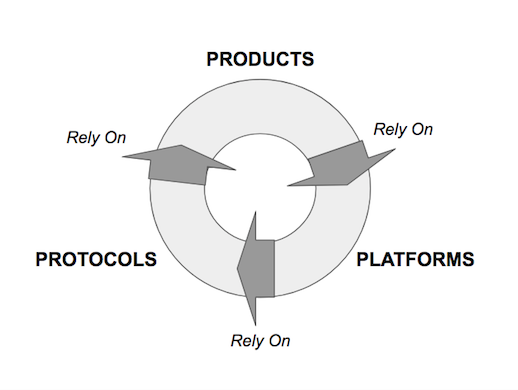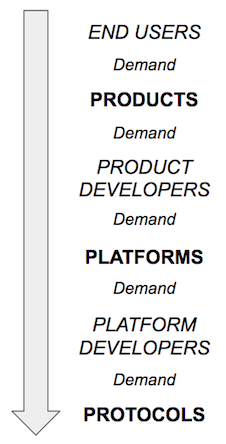Fat Products
Yesterday, I wrote about the layers of blockchain technology.
Products, platforms, and protocols. Assets, tools, and rules.
I noted that there are all kinds of dependencies among products, platforms, and protocols, resulting in every layer of the stack being built at once. Good products rely on secure, friendly platforms. Secure platforms depend on sound, scalable protocols. Protocols hinge upon an asset that, itself, serves as a product.

The flow of dependencies among these layers is circular, but the flow of demand through these layers looks different.
Demand flows from the top-down. End users demand products. Products are built by developers. Developers demand platforms. Platforms are created by engineers. Engineers depend on protocols.

This is significant because demand drives value.
One of the most influential pieces on valuing blockchain technology is Joel Monegro’s note on fat protocols. The idea is that, in blockchain ecosystems, value accrues at the protocol layer as opposed to the application layer.
This is a helpful framework for understanding how protocol technology can be funded and monetized, but it is important to note that protocols are not intrinsically valuable. A protocol is only as good as its products.
Sustaining the astronomic rise in the price of bitcoin this year will depend on it continuing to gain adoption as a product: as a store of value, a means of diversification, and (maybe someday) a form of payment. Maintaining the colossal increase in the price of ether will similarly hinge upon tokens, Ethereum’s products, finding genuine demand among end users.
Many interpretations of fat protocol theory also confuse infrastructure for applications. An investment in bitcoin, the reasoning goes, has fared better than an investment in, say, Coinbase. But Coinbase is not an application of the Bitcoin protocol. Coinbase is a web application that provides infrastructure for the bitcoin product. Like protocols and platforms, infrastructure is only as valuable as the products it serves.
Fat protocol theory glosses over the top-down dynamic of demand. If a protocol accrues value — and keeps it — it is only because its products are delivering value.